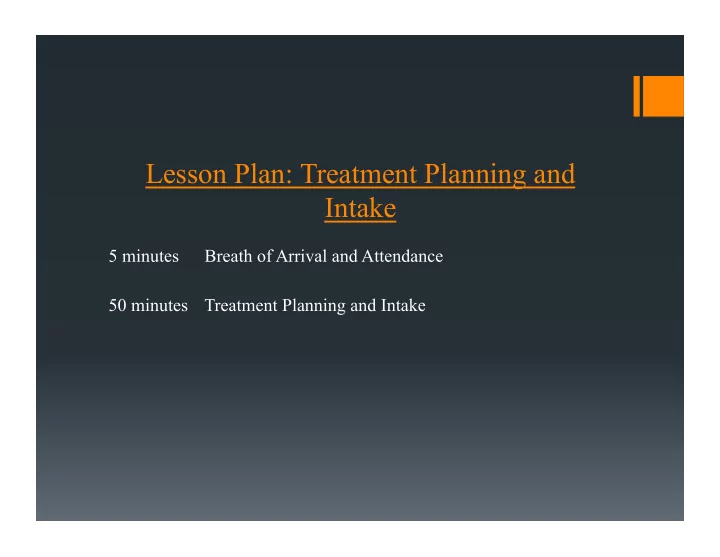

Lesson Plan: Treatment Planning and Intake 5 minutes Breath of Arrival and Attendance 50 minutes Treatment Planning and Intake
Classroom Rules Punctuality- everybody's time is precious: Be ready to learn by 9:00, we'll have you out of here by 1:30 Tardiness: arriving late, late return after breaks, leaving early The following are not allowed: Bare feet Side talking Lying down Inappropriate clothing Food or drink except water Phones in classrooms, clinic or bathrooms You will receive one verbal warning, then you'll have to leave the room.
Treatment Planning and Intake “You know the rule: If you are falling, dive. Do the thing that has to be done.” -Joseph Campbell
Treatment Big Disclaimer – according to Texas’ law you are not allowed to call what you are doing diagnosis or treatment. However, we will use the term “treatment” here as it is, in fact, commonly used in our field.
Introduction Before the massage session begins, decisions are made about how time will be spent in the session, which may be based on: Information from client intake form Goals stated by client Client’s time or financial restraints (or insurance provider) Assessments by therapist Therapist’s training and experience and scope of practice
Introduction Documentation – the process of providing written information regarding client care . More decisions may arise during the session as therapist learns more from the person’s body.
Introduction Treatment plan – essentially therapist’s strategy used to help client achieve his or her therapeutic goals.
Introduction Communication - clear, thoughtful and compassionate communication is important in the intake process. This is a process during formation, evaluation and modification of the treatment plan.
Introduction Assessment – the process involved in evaluating a client’s condition based on subjective reporting and objective findings.
HIPAA The Health Insurance Portability and Accountability Act of 1996 Established standards for consent, record-keeping, confidentiality, and storage of client records. Signed consent form for treatment Signed release if disclosing records to 3 rd party Otherwise keep information private Get permission if sending anything promotional or informational Confidentiality notices on all correspondence Have client form re how you will treat their information.
Documentation Other values of documentation - Sharpens thinking May be used as legal evidence Assist your memory Shows you listen and care
Treatment Planning Take into account – 1) client’s therapeutic goals or reasons for seeking massage therapy 2) current health status 3) info gathered thru intake form 4) answers to questions therapist asks 5) palpation of tissues 6) assessment – e.g. ROM, gait, posture
Client Intake Intake Location Private, safe, well-lit, comfortable Intake Form During the first half of the training, we will use primarily our Massage Clinic’s “Client Intake Form.” Filling out the Form Decide if you will have the client fill out the form or if you will ask the questions and fill it out. The latter takes longer but may give you better opportunity to ask related questions immediately and establish rapport early in the process.
The Interview Insight into their health, possible contraindications, etc. Primary purpose(s) of the session Personal likes or dislikes Length – may allow up to 15 minutes for initial interview.
The Interview Building Rapport Greeting – greet client by name, shake hands clearly & firmly Introduce yourself, why the interview is needed Sit at same eye-level as client Review intake form (if they filled it out already) By end of interview you and your client should have the information you each need to comfortably proceed with the session. Close the interview with “Is there anything else you would like to tell me that I have not already asked?”
The Interview Communication Non-verbal – pay attention to your and your client’s words, tone of voice, gestures, posture and facial expressions. “Generally, the strongest message is the unspoken message, because it is perceived to be the most honest.”
The Interview Interviewing Skills Stay focused Look at your client more than your clipboard . Listen intently and signal your interest Use both open-ended and close-ended questions. Open-ended helps you explore topics with your client. Close-ended – more statement of fact that can be answered yes or no.
Palpation as an Assessment Tool Anomalies Client reaction Edema Twitching Temperature Notice changes in breath; facial expression as signs of it’s working or not working
Formulating the Plan Techniques to be used Areas to include or avoid Duration, frequency, and length of sessions Goals related to improved function Method of reassessment to measure improvement (or lack of improvement) Whether your client needed assistance Use of adjunctive therapies (aromatherapy, hydrotherapy) Self-help techniques and suggestions Referrals (chiropractor, nutritionist) Your client’s general demeanor
After the Massage Suggest self-help techniques Offer your client water Suggest another appointment Answer questions
Updating the Plan Review notes before next session Ask re after effects – changes? positive or negative Goals for today’s session?
Helping Clients Achieve Their Goals Often goals need to be re-examined, updated, or changed. Do not expect 100% improvement – though it’s exciting when that happens. You are not responsible for their results! They do the “healing”. They do self-support. You are responsible to do the very best you can with the very best of your abilities and knowledge within your scope of practice. You do the facilitation and play the role of a good coach – often coaching is non-verbal with your hands! Hold them gently but firmly accountable for reaching their own goals with your help!
Treatment Planning and Intake “You know the rule: If you are falling, dive. Do the thing that has to be done.” -Joseph Campbell
Recommend
More recommend